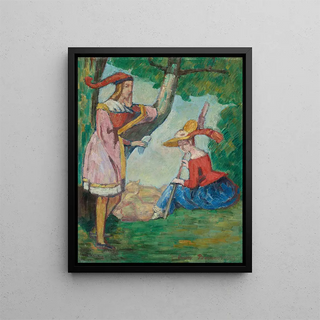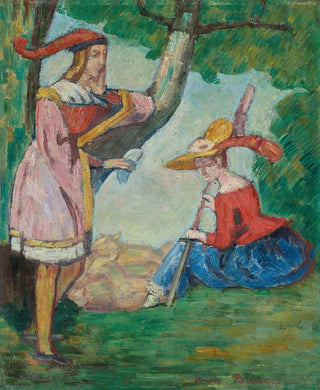Art print | The Schoolgirl - Émile Bernard


View from behind

Frame (optional)
Reproduction L'Écolière - Émile Bernard – Captivating Introduction
Within the vibrant panorama of post-impressionist art, the artwork "L'Écolière" by Émile Bernard stands out as a masterpiece, captivating the eye and mind with its delicate and introspective atmosphere. This depiction of a young student, immersed in her thoughts, evokes a gentle melancholy while celebrating the beauty of the present moment. The scene, bathed in soft light and a palette of harmonious colors, invites the viewer to enter the protagonist's intimate universe. Through this piece, Bernard manages to capture not only an image but also an emotion, a reflection on education and youth, all anchored in refined aesthetics.
Style and uniqueness of the work
Émile Bernard's style is distinguished by his ability to blend various influences while forging a unique identity. In "L'Écolière," the cloisonnism technique, which Bernard developed, is evident through sharp outlines and flat areas of color that structure the composition. The forms are simplified, almost geometric, yet retain striking expressiveness. The light, omnipresent in the artwork, plays a crucial role, illuminating the face of the student and creating a striking contrast with the surrounding shadows. This stylistic approach, which aims to be both modern and rooted in a pictorial tradition, demonstrates technical mastery and artistic sensitivity that make Bernard a pioneer of his time. The piece, through its nuances and details, reveals a rich inner world where each brushstroke seems to tell a story— that of a youth seeking knowledge and meaning.
The artist and his influence
Émile Bernard, an emblematic figure of the post-impressionist movement, established himself on the late 19th-century art scene. A student of Paul Gauguin, he absorbed his mentor's lessons while developing a distinctive style of his own. His quest for a more spiritual and symbolic expression of reality led him to explore various themes, ranging from nature to everyday life. Bernard also played a significant role in disseminating artistic ideas

Matte finish

View from behind

Frame (optional)
Reproduction L'Écolière - Émile Bernard – Captivating Introduction
Within the vibrant panorama of post-impressionist art, the artwork "L'Écolière" by Émile Bernard stands out as a masterpiece, captivating the eye and mind with its delicate and introspective atmosphere. This depiction of a young student, immersed in her thoughts, evokes a gentle melancholy while celebrating the beauty of the present moment. The scene, bathed in soft light and a palette of harmonious colors, invites the viewer to enter the protagonist's intimate universe. Through this piece, Bernard manages to capture not only an image but also an emotion, a reflection on education and youth, all anchored in refined aesthetics.
Style and uniqueness of the work
Émile Bernard's style is distinguished by his ability to blend various influences while forging a unique identity. In "L'Écolière," the cloisonnism technique, which Bernard developed, is evident through sharp outlines and flat areas of color that structure the composition. The forms are simplified, almost geometric, yet retain striking expressiveness. The light, omnipresent in the artwork, plays a crucial role, illuminating the face of the student and creating a striking contrast with the surrounding shadows. This stylistic approach, which aims to be both modern and rooted in a pictorial tradition, demonstrates technical mastery and artistic sensitivity that make Bernard a pioneer of his time. The piece, through its nuances and details, reveals a rich inner world where each brushstroke seems to tell a story— that of a youth seeking knowledge and meaning.
The artist and his influence
Émile Bernard, an emblematic figure of the post-impressionist movement, established himself on the late 19th-century art scene. A student of Paul Gauguin, he absorbed his mentor's lessons while developing a distinctive style of his own. His quest for a more spiritual and symbolic expression of reality led him to explore various themes, ranging from nature to everyday life. Bernard also played a significant role in disseminating artistic ideas






